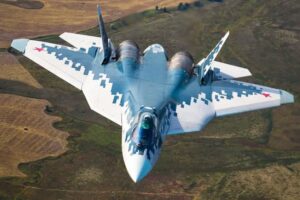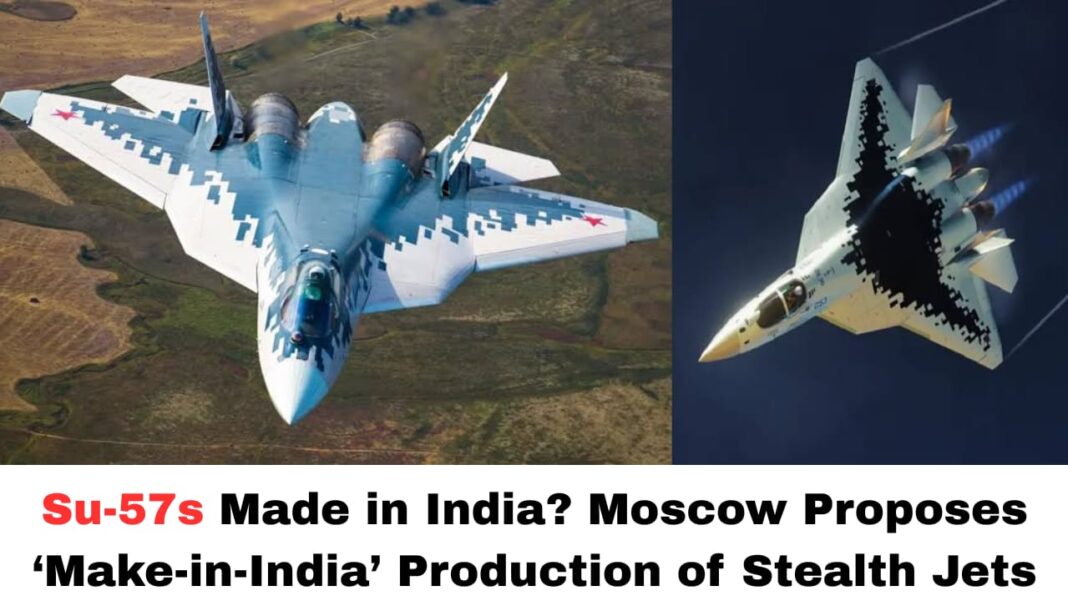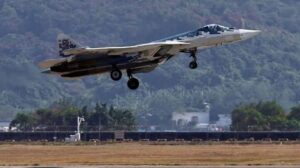Digital News Guru National Desk:
India at a Strategic Crossroads: Russia’s Su-57 Make-in-India Proposal
India stands at a pivotal juncture in its defense modernization journey, weighing the promise of advanced air capabilities against its longstanding push for technological self-reliance. A recent overture from Russia—the potential local manufacture of Su-57 fifth-generation stealth fighters in India—could reshape the future of India’s defense industry.
Key Developments
- Feasibility Study Underway
Russia is currently evaluating the cost and feasibility of producing the Su-57 within India under the “Make-in-India” framework. Discussions include options for technology transfer and local production lines.

- India’s Air Force Requirements
India has signaled a requirement for two to three squadrons of advanced fifth-generation fighters, with both the Su-57 and the U.S. F-35 being considered. - Leverage Existing Infrastructure
The Su-30MKI production facilities at HAL’s Nashik plant may be repurposed with minimal retooling—estimated at less than 30%—to manufacture Su-57 jets, significantly cutting down setup costs and timelines - Full Technology Transfer on the Table
Russia’s offer includes complete transfer of technology (ToT) and local customization of the Su-57, with potential for Indian avionics and systems to be integrated. - Strategic Timing and Diplomatic Context
This proposal emerges in the context of deepening India–Russia defence collaboration, while India simultaneously pushes for greater self-reliance and considers its own Advanced Medium Combat Aircraft (AMCA) development efforts
What’s on the Table
During recent discussions under the “Make-in-India” initiative, Russia has begun exploratory studies assessing the feasibility and cost implications of producing the Su-57 in India. Discussions reportedly include proposals for comprehensive technology transfer and localized manufacturing. Hindustan Aeronautics Limited’s (HAL) Nashik facility—renowned for assembling over 200 Su-30MKI aircraft—has been identified as the ideal site for this collaboration. Taking advantage of existing infrastructure could significantly reduce both time and cost to bring the Su-57 into Indian production.
Details of the Offer
The proposal from Russia is both expansive and strategically significant. It includes:
- Full technology transfer: Russia is reportedly willing to share source code, avionics designs, and allow Indian system integrations—an offer reminiscent of no previous fifth-generation fighter deal globally.

- Initial off-the-shelf jets: To meet immediate operational needs, Russia may supply 20–30 Su-57E variants directly, while local production scales up over 3–4 years.
- Customization potential: The Su-57E could incorporate homegrown systems such as AESA radar, mission computers, and Indian armaments to ensure interoperability with existing Indian platforms.
Context & Strategic Timing
India’s ambition for two to three squadrons of fifth-generation fighters has brought both the Su-57 and the U.S. F-35 into consideration. While the F-35 offers Western cutting-edge stealth and integration, its restrictive technology terms and lack of co-production temper India’s interest.
Meanwhile, India is actively pursuing its indigenous Advanced Medium Combat Aircraft (AMCA) project. However, given AMCA’s projected prototype debut in 2028–29 and first flight thereafter, the Su-57 deal offers a near-term capability infusion while buttressing long-term self-reliance.
Benefits for India
- Operational Autonomy: Full access to Su-57 systems and software empowers India to modify, maintain, and upgrade the platform independently—critical in an era of complex geopolitical pressures.
- Industrial Upside: Leveraging existing HAL infrastructure accelerates deployment while catalyzing partnerships with domestic aerospace entities—fueling job creation and defense industrial growth.
- Strategic Buffering: Local production minimizes exposure to international sanctions and supply chain disruptions.
- Continuity & Familiarity: Building upon India’s legacy of licensing and operating Russian platforms, the Su-57 move would fit smoothly within logistics and operational frameworks.
Challenges Ahead
- Capital & Infrastructure: Though leveraged facilities exist, scaling up to full-scale source-code-enabled manufacturing demands significant investment and rigorous oversight.
- Balancing Partnerships: Deepening ties with Russia may complicate India’s expanding defense ties with the U.S., particularly amid CAATSA sanctions and evolving alignment dynamics.
- Technology Risks: Long-term viability of Su-57 hinges on sustaining relevance amid evolving combat requirements and geopolitical shifts.
Strategic Implications
Should India move forward, the Su-57 deal would mark a landmark shift in its defense industrial trajectory—transforming the country from a major arms importer to a potential export-capable aerospace power. It would provide immediate aerial modernization while fueling indigenous innovation and robust self-sufficiency. Conversely, rejecting the offer may steer India further toward Western platforms but at the cost of autonomy and industrial participation.
Conclusion
In the chessboard of great-power competition and regional volatility, India’s defense procurement choices resonate deeply. Russia’s Su-57 proposal—offering co-production, technology transfer, and operational control—presents a rare and transformative opportunity. For New Delhi, it’s more than a purchase; it’s a strategic bet on sovereignty, capability, and industrial future—and a defining moment in the country’s quest to chart an independent and ambitious path.
You May Also Read: No Helmet, No Fuel: UP’s Bold One-Month Push for Road Safety









